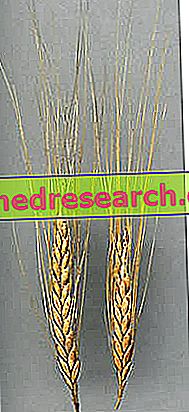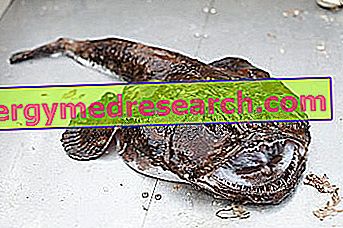Generality
Spelled is a product of vegetable origin, more precisely a cereal; as such, it belongs to the third group of foods and supplies mainly starch (therefore "energy"), fibers, magnesium, potassium and some vit. of group B (if integral, especially niacin).

Like common wheat, spelled also contains gluten and is not suitable for celiacs. It is sold in the form of whole or peeled and dried seeds, and refined or wholemeal flour; very often, spelled is an essential ingredient of "soup" type first courses.
Spelled can be differentiated into 3 Well-defined species: small, medium and large, all belonging to the Gramineae family ( Poacee ) and the Triticum genus: these three different Species are, in order, T. monococcum (small spelled), T dicoccum (medium spelled) and T. spelta (large spelled).
Spelled was one of the very first cereals to be harvested and then cultivated by humans. Unfortunately, following its importation (probably attributable to Roman legionaries), in our country it was almost completely replaced by Triticum durum and Triticum aestivum (durum wheat and soft wheat); today, its consumption is considered as a therapeutic dietary intervention. In reality, the nutritional values of spelled are almost the same as those of "traditional" wheat (with a slight advantage in protein content), although being used mainly in the form of whole seeds (in soups and soups), it helps to reduce in sensible way the total caloric intake of the diet (it brings more water and less carbohydrates than dry pasta). Still compared to wheat, the cultivation of spelled is characterized by a lower yield of the plant and by a greater expenditure in the technological processing of the seeds. This last aspect concerns the separation of the husk (fibrous portion) from the grains of the cereal; this intervention, for morphological reasons, requires an additional decortication intervention with respect to wheat.
It is however necessary to specify that, in Italy, the traditional spelled-based recipes are still many; in the central regions, especially in Umbria and Tuscany (where the major crops of this cereal are still concentrated), it is still possible to find many spelled-based foods.
Spelled Salad
X Problems with video playback? Reload from YouTube Go to Video Page Go to Video Recipes Section Watch the video on youtubeSee also the spelled milk video recipe
Description and habitat
Spelled is structurally similar to common wheat. It is a herbaceous plant that produces inflorescences organized in spikes, in which to each flower corresponds a fruit / caryopsis; however, compared to wheat, the three farri produce a significantly lower volume of edible portion. The least profitable is also the oldest one, namely small spelled; followed by medium spelled (the one produced in Italy) and finally spelled. It seems that the latter does not belong to a natural Species; it is in fact a cross between the middle spelled and another wild grass. The area of origin of the various types of spelled is more or less the same, or that is between the eastern portion of the Mediterranean basin, the Caucasus and the northern portion of the Middle East (same band of meridians).
| Composition for 100g of Spelled - Reference values of the INRAN Food Composition Tables | ||||||||||||||||||||||||||||||||||||||||||||||||||||||||||||||||||||||||||||||||||||||||||||||||||||||||||||||||||||||||||||||||||||||||||||
 | ||||||||||||||||||||||||||||||||||||||||||||||||||||||||||||||||||||||||||||||||||||||||||||||||||||||||||||||||||||||||||||||||||||||||||||
Nutritional values (per 100 g of edible portion)
| ||||||||||||||||||||||||||||||||||||||||||||||||||||||||||||||||||||||||||||||||||||||||||||||||||||||||||||||||||||||||||||||||||||||||||||
Spelled DOES NOT grow in areas with a cold temperate climate, but not even in tropical ones; it prefers regions with a Mediterranean climate or slightly cooler. The small differences between the ideal climate of one or the other Species have determined the selection in the cultures of the various countries; in Italy, for example, medium spelled (Mediterranean par excellence) is most widely cultivated, while spelled is quite widespread in Eastern Europe.
Gastronomic uses and nutritional characteristics of spelled
As anticipated, spelled contains gluten. This makes it suitable for baking and, not surprisingly, since ancient times its flours have been used in the production of focaccia. Today, even spelled pasta is a rather well-known food (but not as much as traditional food).
Spelled flour and spelled seeds can be found in two forms: refined and whole. Both are made from grains deprived of glume and glumelle, but the refined one has an extremely small portion of dietary fiber. Spelled lends itself to the composition of soups, soups with legumes, potatoes and vegetables, first courses similar to risotto etc. In essence, spelled completely replaces the use of wheat.
The nutritional composition of spelled is rather similar to that of durum wheat and soft wheat; the protein intake is slightly higher but it is certainly not its most important characteristic. Spelled is a cereal and, as such, contains excellent amounts of complex carbohydrates that determine its high energy density. The lipid content is negligible and the fiber content is good.
With regard to mineral salts, the following table shows excellent concentrations of potassium and phosphorus but, in the integral product, magnesium should also be present in more than satisfactory quantities.
No sufficiently detailed information is available to establish the magnitude of the vitamin content but it is conceivable that an excellent concentration of niacin can be appreciated in wholemeal spelled.


